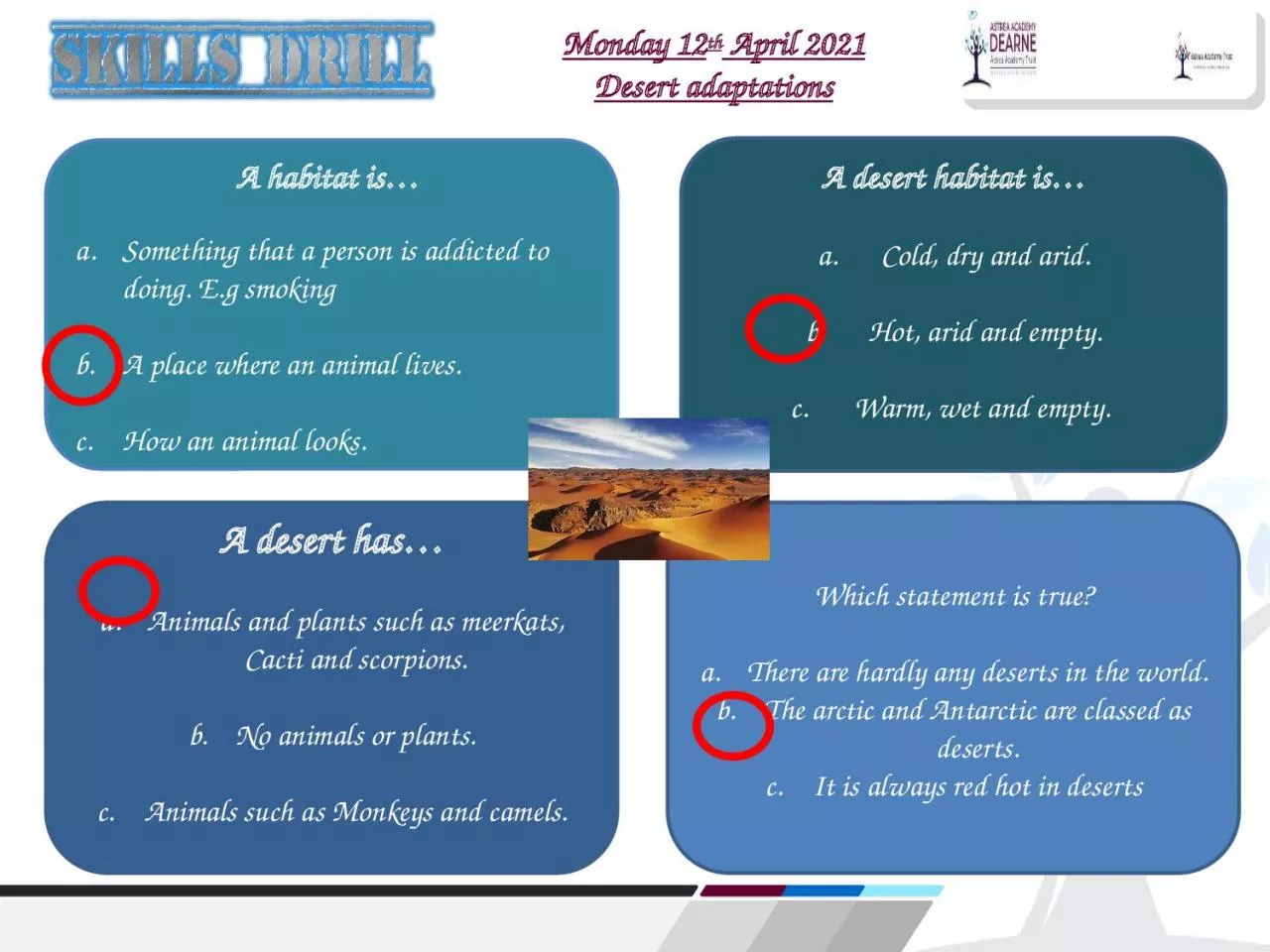

Desert adaptations A habitat is Something that a person is addicted to doing Eg smoking A place where an animal lives How an animal looks A desert habitat is Cold dry and arid ID: 933155
Download Presentation The PPT/PDF document "Monday 12 th April 2021" is the property of its rightful owner. Permission is granted to download and print the materials on this web site for personal, non-commercial use only, and to display it on your personal computer provided you do not modify the materials and that you retain all copyright notices contained in the materials. By downloading content from our website, you accept the terms of this agreement.
Slide1
Monday 12
th
April 2021Desert adaptations
A habitat is… Something that a person is addicted to doing. E.g smokingA place where an animal lives.How an animal looks.
A desert habitat is…Cold, dry and arid.Hot, arid and empty.Warm, wet and empty.
A desert has…Animals and plants such as meerkats, Cacti and scorpions. No animals or plants.Animals such as Monkeys and camels.
Which statement is true?There are hardly any deserts in the world.The arctic and Antarctic are classed as deserts.It is always red hot in deserts
Slide2KEYWORD ALERT!
Adapt
ation
In science this means how an animal suits its habitat. For exampleAn orangutan lives in a rainforest with lots of trees to climb. It is suited to that environment because it has long arms to reach for trees and swing
.
Slide3A habitat is a place where something lives.
There are many different types of habitats:
hot or cold
big or small
on land or in waterName 5 different habitats.
For example:A desert.Name 2 animals that live in one of the habitats you have mentionedSTRETCH: Name some of the
features of the habitat you have named.(e.g mountains, rivers, trees, plants, sand, mud, water, coral, houses)
Slide4Learning Objectives:
-State some adaptations of an animal from a desert environment.
-Describe some adaptations of an animal from a desert environment.
-Explain how these adaptations are important for surviving a desert habitat.
Slide5Adaptations of a Camel
Can run up to 40mph in a sprint, or maintain 25mph for up to an hour.
Can consume up to 46 litres of water in one sitting.
Three rows of eyelashes.
Large, flat feet.
Thick fur on the top of their bodies; thin fur elsewhere.
Thin, slot-like nostrils.
LO: State
some adaptations of an animal from a desert environment
Slide6Three rows of eyelashes.
Protection from sandstorms/strong winds.
LO: Describe
some adaptations of an animal from a desert environment
Slide7Thin, slot-like nostrils.
Prevents sand from entering the body and
damaging
the lungs. It protects the breathing of the camel
LO: Describe
some adaptations of an animal from a desert environment
Slide8Can consume up to 46 litres of water in one sitting.
Water is scarce and this allows them to hydrate and
replenish
stored water quickly
.This water gets stored as fat in the camels hump.
Replenish means to fill something up again.
Slide9Thick fur on the top of their bodies; thin fur elsewhere.
Thick fur provides
shade, stopping the camel getting sunburn and
thin fur
stops the camel over heating. LO: Describe some adaptations of an animal from a desert environment
Slide10Can run up to 40mph in a sprint, or maintain 25mph for up to an hour.
To travel quickly across the desert over long distances and to allow air to circulate underneath their stomachs to cool them down.
LO: Describe
some adaptations of an animal from a desert environment
Slide11Large, flat feet.
Spreads weight on soft
sand so they don’t sink in.
LO: Describe
some adaptations of an animal from a desert environment
Slide12Camel Adaptations
Adaptation
What’s the Point?
Can run up to 40mph in a sprint, or maintain 25mph for up to an hour.
To travel quickly across
the desert over long distances and to allow air to circulate underneath their stomachs to cool them down.
Can consume up to 46 litres of water in one sitting.
Water is scarce and this allows them to hydrate and replenish stored water quickly.
Three rows of eyelashes.
Protection from sandstorms/strong winds.
Large, flat feet.
Spreads weight on soft sand.
Thick fur on the top of their bodies; thin fur elsewhere.
Thick fur provides shade, thin fur aids heat loss.
Thin, slot-like nostrils.
Prevents sand from entering the body and
damaging breathing.
LO: Describe
some adaptations of an animal from a desert environment
Slide13Desert plants
Cacti are also well adapted for survival in the desert. Their adaptations include:
stems that can store water
widespread root systems that can collect water from a large area
In addition, cacti have spines instead of leaves. These minimise the surface area and so reduce water loss. The spines also protect the cacti from animals that might eat them.
Slide14Match up the camel adaptation to how it helps
. Write them in full sentences.
STRETCH:
Explain how two of the adaptations help camel to survive. What might happen if they didn’t have this adaptation?Example:WAGOLLCamels have large flat feet to help spread their weight on the soft sand.
Sentence starters:Camels have…This helps because…
Slide15Mammal
Reptile Bird
Write the three subtitles and organise the animals into the right animal group.LionHumanEagle
PenguinChickenLizardCrocodileSnake
ElephantcowAlligatorEmu
Meerkat
Slide16Mammal
Reptile
BirdWrite the three subtitles and organise the animals into the right animal group.LionHuman
EaglePenguinChicken
LizardCrocodileSnakeElephantcow
AlligatorEmu
Meerkat